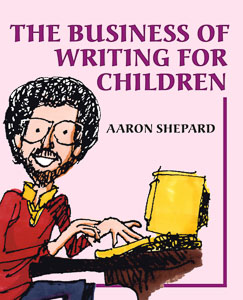When I speak at a school, library, or bookstore, I usually read one of my works in progress. Afterwards, I might ask one of the adults, “Do you think that story would make a good picture book?”
“Oh, yes!” is the frequent answer. “I could see all the pictures!”
That’s what I aim for. In the words of a long-forgotten source, “I write words that make pictures.”
I’m not talking about colorful metaphors or spicy adjectives or loads of descriptive detail. I’m talking about drawing readers into the story and engaging their imaginations, so they create the pictures themselves.
To draw readers in, you must be concrete. To keep them there, you must be invisible.
Being Concrete
If you want readers to picture the action, picture it first yourself. I visualize my stories as a series of scenes, much as in a play. Each scene opens in a specific location at a specific time. The action unfolds as the characters speak and move about the stage. Then the scene ends and the curtain comes down in preparation for the next scene.
Here’s how I transfer the scene to text:
The curtain rises. I make sure my readers know right away exactly where and when they are. That way, the scenery will be in place in their mental pictures.
The action unfolds. I see a character move. I describe the movement so the reader can see it too. I hear a character speak. I transcribe the words so the reader can hear it too. Note: I don’t describe the speeches (indirect quote), I give the words as the reader would hear them (direct quote).
If I’m tempted to write something I don’t see or hear, I think twice. Can’t the characters do something on stage that will do the same job? For instance, my characters usually talk to themselves instead of thinking silently.
The curtain falls. What happens then? Nothing, until the next scene. I follow this rule fairly strictly because I write picture books, and the curtain corresponds to page turns. But for any story, action should not stay disembodied very long.
Descriptions of scenery, characters, and action can be extremely sketchy. A reader’s imagination is a wonderful thing. Give it a small suggestion and it fills in the rest.
Being Invisible
A few years ago, at the National Storytelling Festival in Jonesborough, Tennessee, I was listening to a tale being told by Connie Regan-Blake, a member of a prominent storytelling duo called the Folktellers. She was performing in a huge tent on a hot day to an audience of about a thousand adults. Her delivery was solid and skilled, but not really striking.
All at once, in the middle of the story, I “woke up” with a shock. For just a few seconds, I had completely forgotten I was sitting in a hot tent with a thousand other people—forgotten even that I was listening to Connie Regan-Blake. She had drawn me into the story so completely that I was aware of nothing but that story’s unfolding within my own mind.
That moment taught me that the height of storytelling—oral or written—is when the teller becomes invisible.
Part of becoming invisible is to engage the reader’s imagination with concrete images, as discussed earlier. If the imagination is busy enough, it will wrap the reader up in the story and draw attention away from the writer. (In the words of the great and powerful Wizard of Oz, “Pay no attention to that man behind the curtain!”)
At the same time, though, the writer must carefully avoid drawing attention back to the text. Here are some things that will “distance” a reader from the story:
Obscurity and ambiguity. The text must be crystal clear, so readers don’t have to stop and figure things out. Make your meaning obvious, and never make your readers choose between two possible meanings. Don’t skimp on a comma if it’s needed to show clearly where one phrase ends and the next begins.
Remember, text is a linear medium. Don’t make a reader double back to get the meaning of text that came earlier. For instance, readers should never have to wonder who is doing what. Subjects should generally be at the start of sentences. Attributions of dialog should come no later than after the first sentence. If that sentence is a long one, put the attribution between clauses, or even add a short exclamatory sentence in front.
Fancy language and long descriptions. Language should be rhythmic and artful, but at the same time simple and direct. Sophisticated, complex, or gimmicky language becomes the focus of attention.
You might think that extensive description would bring readers deeper into the story, but the opposite is generally true. This is because long descriptive passages break the action. In essence, you’re asking your characters to freeze in place until you’re done. Readers are more caught up when the action takes place in “real time.”
Narrator intrusion. This happens when a writer inserts a personal comment, judgment, or opinion into third-person narrative, or worst of all, addresses the reader directly. Readers at once become acutely aware of the writer lurking behind the words—or in front of them. A single indiscreet adjective can bring a reader up short.
A few writers, like Roald Dahl, can purposely intrude themselves and pull it off wonderfully. Most of us, though, do better to keep the narrative tone strictly objective and let the story speak for itself.
Ironically, when you make your text less visible, your prose may draw less notice and less praise. It may even be criticized as plain. But you’ll know better when you see young listeners staring up with wide, glazed eyes.
You’ll know that your words are making pictures.
